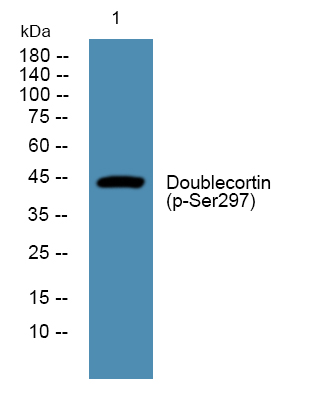Doublecortin (Phospho Ser297) rabbit pAb
- Catalog No.:YP1316
- Applications:WB
- Reactivity:Human;Rat
- Target:
- Doublecortin
- Gene Name:
- DCX DBCN LISX
- Protein Name:
- Doublecortin (Ser297)
- Human Gene Id:
- 1641
- Human Swiss Prot No:
- O43602
- Mouse Gene Id:
- 13193
- Mouse Swiss Prot No:
- O88809
- Rat Swiss Prot No:
- Q9ESI7
- Immunogen:
- Synthesized phosho peptide around human Doublecortin (Ser297)
- Specificity:
- This antibody detects endogenous levels of Human Rat Doublecortin (phospho-Ser297)
- Formulation:
- Liquid in PBS containing 50% glycerol, 0.5% BSA and 0.02% sodium azide.
- Source:
- Polyclonal, Rabbit,IgG
- Dilution:
- WB 1:1000-2000
- Purification:
- The antibody was affinity-purified from rabbit serum by affinity-chromatography using specific immunogen.
- Concentration:
- 1 mg/ml
- Storage Stability:
- -15°C to -25°C/1 year(Do not lower than -25°C)
- Other Name:
- Neuronal migration protein doublecortin (Doublin) (Lissencephalin-X) (Lis-X)
- Observed Band(KD):
- 44kD
- Background:
- This gene encodes a member of the doublecortin family. The protein encoded by this gene is a cytoplasmic protein and contains two doublecortin domains, which bind microtubules. In the developing cortex, cortical neurons must migrate over long distances to reach the site of their final differentiation. The encoded protein appears to direct neuronal migration by regulating the organization and stability of microtubules. In addition, the encoded protein interacts with LIS1, the regulatory gamma subunit of platelet activating factor acetylhydrolase, and this interaction is important to proper microtubule function in the developing cortex. Mutations in this gene cause abnormal migration of neurons during development and disrupt the layering of the cortex, leading to epilepsy, mental retardation, subcortical band heterotopia ("double cortex" syndrome) in females and lissencephaly ("smooth brain&quo
- Function:
- alternative products:Isoform LIS-XA possesses an alternative exon in 5' and is then translated from an upstream initiation codon. Isoform LIS-XB, isoform LIS-XC and isoform LIS-XD translation starts at the downstream initiation codon, leading to the absence of the 81 first amino acids. Isoform LIS-XC and isoform LIS-XD differ from isoform LIS-XB by a five amino acids and a one amino acid-insertion respectively,disease:A chromosomal aberration involving DCX is found in lissencephaly. Translocation t(X;2)(q22.3;p25.1).,disease:Defects in DCX are the cause of lissencephaly X-linked type 1 (LISX1) [MIM:300067]; also called X-LIS or LIS. LISX1 is a classic lissencephaly characterized by mental retardation and seizures that are more severe in male patients. Affected boys show an abnormally thick cortex with absent or severely reduced gyri. Clinical manifestations include feeding problems, abno
- Subcellular Location:
- Cytoplasm . Cell projection, neuron projection . Localizes at neurite tips. .
- Expression:
- Highly expressed in neuronal cells of fetal brain (in the majority of cells of the cortical plate, intermediate zone and ventricular zone), but not expressed in other fetal tissues. In the adult, highly expressed in the brain frontal lobe, but very low expression in other regions of brain, and not detected in heart, placenta, lung, liver, skeletal muscles, kidney and pancreas.
- June 19-2018
- WESTERN IMMUNOBLOTTING PROTOCOL
- June 19-2018
- IMMUNOHISTOCHEMISTRY-PARAFFIN PROTOCOL
- June 19-2018
- IMMUNOFLUORESCENCE PROTOCOL
- September 08-2020
- FLOW-CYTOMEYRT-PROTOCOL
- May 20-2022
- Cell-Based ELISA│解您多样本WB检测之困扰
- July 13-2018
- CELL-BASED-ELISA-PROTOCOL-FOR-ACETYL-PROTEIN
- July 13-2018
- CELL-BASED-ELISA-PROTOCOL-FOR-PHOSPHO-PROTEIN
- July 13-2018
- Antibody-FAQs
- Products Images

- Western blot analysis of lysates from PC12 cells, primary antibody was diluted at 1:1000, 4°over night



